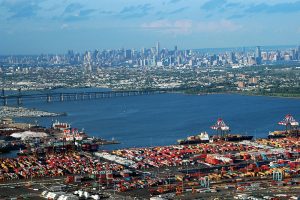NY-NJ Port Terminal Spending Hundreds of Millions to Increase Capacity

The island of Manhattan and areas of the New York / New Jersey Port seen from aboard a plane in July, 2005 by Maureen on flickr.
The Port Newark Container Terminal is spending big bucks to more than double its capacity.
Hugh R. Morley reported in the Journal of Commerce:
The installation of a new computer “brain” at Port Newark Container terminal three weeks ago that coordinates the operation of the entire terminal is part of a plan that is expected to eventually cost more than $500 million and includes land acquisition, a new gate, a dredging project, new cranes, and an additional berth. The upgrade will eventually increase the terminal’s capacity from about 1 million containers a year to 2.4 million containers per year by 2020.
$500 million is, of course, a lot of money. However, it will be well worth the investment if the Port of New York and New Jersey can increase its portion of market share, taking cargo movement from West Coast ports like the Ports of Los Angeles and Long Beach.
The Port Newark Container Terminal is one of the major terminals at the Port of New York and New Jersey. The terminal is in an excellent position for considerable growth.
The expansion of the Panama Canal, which was finally completed last year, really creates opportunity for East and Gulf Coast ports to increase their market share of handling Asia to U.S. imports. That opportunity got a shot in the arm when many shippers lost trust in West Coast ports during the terrible and hugely costly congestion during the labor strife of the 2014/2015 contract negotiations between the International Longshore & Warehouse Union (ILWU) and Pacific Maritime Association (PMA).
The challenge for East and Gulf Coast ports is accommodating the larger ships that carriers can now send through the Panama Canal.
When it comes to New Panamax ships, the Port Newark Container Terminal cannot even be reached by them yet because the ships’ access to the terminal is blocked by a bridge.
We wrote before in this blog about a project to raise the clearance of that bridge, the Bayonne Bridge, from just over 150 feet to over 200 feet. That project is almost complete, so the Port Newark Container Terminal needs to be ready to receive the bigger ships that can soon get through.
Really, there is no choice but for ports to spend big money on projects like dredging, getting bigger cranes, and infrastructure. The ocean carriers have seen to that.
With their eyes on saving money through the efficiency of moving more shipping containers–and cargo in general–at once, carriers have moved to larger ships with no looking back. On top of that, the carriers work together in alliances to fill those ships.
Therefore, ports have to be able to accommodate larger ships delivering much larger amounts of cargo at once.
More than doubling its capacity will give the Port Newark Container Terminal a great chance at grabbing cargo movement from shippers, who are more and more limited in diversifying when it comes to carriers but want to diversify from West Coast ports.
Ports around the country and the world are also spending big money on upgrades in order to compete and just survive.



